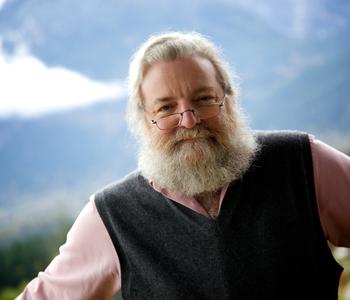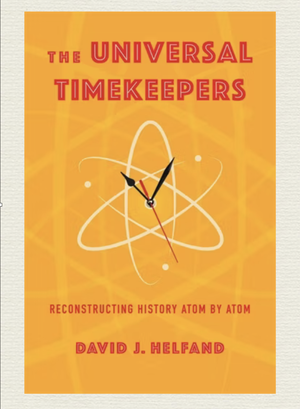David J. Helfand The Universal Timekeepers: Reconstructing History Atom by Atom Columbia University Press 288 pages, 6 x 9 inches, ISBN 9780231219037
In a Nutshell
This book is about nothing. Or at least 99.999999999999% bits of nothingness. And yet it is about everything – all that you can touch, see, taste, smell, and feel, and you, and the room in which you are sitting, and this planet, our solar system, the Milky Way, and the entire visible Universe. All of it is composed of the bits of nearly completely empty space we call atoms.
You’ve never seen an atom because, besides being mostly empty space, they are very, very small: it takes 15 million trillion of them to make one poppy seed. If the atom were the size of a small marble, it would take a warehouse covering a full city block, twenty stories tall, to contain 1 trillion. Fifteen million trillion would be a warehouse covering all of New York State and extending upward to thirty stories. A lot of marbles.
Despite their infinitesimal size and ephemeral nature, we have developed an intimate relationship with atoms. We can count them individually. We can distinguish the 118 different types and the dozen or two flavors in which each type exists. We can transform them from one type to another and can query their interior states. Most importantly, we can take advantage of their imperturbable internal clocks to reconstruct the history of the Universe.
This book provides an accessible introduction to atoms and describes how we can use them as unbiased historians. From the detection of art forgeries to the dating of archeological artifacts, from the history of agriculture and human diet to the complex story of Earth’s constantly changing climate, the little atomic historians are faithful guides. From the death of the dinosaurs 66 million years ago to the origin of life more than 3.5 billion years ago, atoms recount the story. The solar system’s birthday is determined precisely; the history of the Universe and all it contains, back to the first fraction of a second of its existence 13.8 billion years ago -- all is revealed in striking detail by atoms, the universal timekeepers.
The wide angle
The United Nations has declared 2025 the Year of Quantum Science and Technology to mark the 100th anniversary of our foundational model of the atomic world, quantum mechanics. This model is the most precise predictive description we have in all of science. Its theoretical calculations are verified by experiments to 9 or 10 decimal places. This level of understanding makes the modern world – from cell phones and cameras to solar panels and electric cars -- possible. But it also provides a unique set of tools with which to explore space and time.
I have a passion for sharing the enriched view of the world that science provides. Thus, most of my five decades of teaching have been spent offering science courses designed for non-science majors. From an initial meander from my astrophysical roots into paleoclimatology – the reconstruction of past climates from the atomic record – my interest spread to the many other applications of atomic physics, chemistry, biology, and geology that reveal the past through techniques that clever people have devised over the last half century. Thus, this book.
By measuring the pattern of light from a primordial galaxy 13 billion light-years away, we can see that the Carbon atoms there are identical to the Carbon atoms in my fingernail. By determining the ratio of the different flavors of Carbon atoms in ancient bones, we can chart the spread of maize agriculture from the highlands of Mexico to New England 5000 years later. From the same sort of ratio in the neuronal DNA in a human brain, we can establish that new nerve cells are being formed in our memory center throughout our lives. Simply counting atoms provides all these insights and many more.
A close-up
Recounting the detailed life story of a long-extinct woolly mammoth may seem fantastically impossible, but our little atomic historians are up to the task.
The “flavors” of different atoms referred to above -- called isotopes -- arise from the different number of neutrons compared to the number of protons in the atomic nucleus. The proton number fixes the type of atom it is; e.g., Carbon always has 6 protons, Nitrogen 7, and Oxygen 8. For these relatively light elements, the most stable ratio of protons to neutrons is 1:1. Thus, the most abundant flavors of Carbon, Nitrogen, and Oxygen have 6, 7, and 8 neutrons, respectively; we label the isotopes with the sum of neutrons plus protons, so these are designated C-12, N-14, and O-16.
Being off by just one or two neutrons can still yield a stable nucleus. The next most common flavor of these three elements is C-13, N-15, and O-18. But if the ratio departs too far from the optimal one, the nucleus becomes unstable. C-14 is such an isotope. We say it is radioactive and thus will spontaneously transform itself to N-14 by changing one of its extra neutrons to a proton. The critical feature of this transformation is that it occurs at a completely predictable – and unalterable – rate. For C-14, half of a sample will transform in 5730 years.
Since the decay of an individual nucleus is a strictly random event, this does not mean the sample will have disappeared in another 5730 years. The nucleus has no memory, and certainly does know when you started counting – it always has a 50% chance of decaying in the next 5730 years. Thus, half of the remaining (or one-quarter) will be left after 2 x 5730 years, and one-eighth will remain after 3 x 5730 years. Thus, the ratio of C-14 to C-12 atoms provides a clock accurate to a decade or two over the last 50,000 years.
As for our mammoth, the C-14/C-12 tells us it was born 14,100 years ago near the Yukon River delta in Alaska. Since, as with all living things, the mammoth is what it eats – atom by atom, isotope by isotope – the isotopic composition of its tusks provides a detailed, continuous record of its life. The ratio of Strontium isotopes in the soil varies significantly over even short distances, and such ratios – from the soil to the plants to the mammoth’s mouth to his tusks – allow us to infer his grazing location, week by week, for 28 years! The O-18/O16 ratio shows seasonal migrations since this ratio reflects both the temperature and the distance from the ocean; it indicates a departure from the matrilineal herd at age 12, the same age when such separations occur today in modern elephant herds. Perhaps unwisely, our mammoth then moves north of the Brookes Range, where, sadly, the Nitrogen ratio N-15/N14 shows a dramatic rise just before his demise, indicating he was digesting his own protein (which is richer in N-15) as he starved to death.
Lastly
When I look at a flower, I see what everyone else sees, but I also see much more. I imagine the molecular structures that have assembled atoms into a configuration that absorbs some wavelengths of light and reflects others (the colors I see). I imagine what the flower would look like to a bee, which can see wavelengths 30% shorter than those to which my eyes are sensitive – a flower pattern transformed. I conjure up the strands of DNA in the nucleus of each flower cell, programming the arrays of proteins that orchestrate the flower’s opening.
I see the leaves breathing in Carbon Dioxide from the air, using sunlight to break the Carbon-Oxygen bond, releasing the O2 for me to breathe while incorporating the C into cellulose and other plant molecules. I can picture how the plant discriminates against the heavier, slower-moving C-13- and C-14-containing molecules of CO2, knowing that I can use the exact isotope ratios to determine the plant species and its age if I were to come across a pressed petal of the flower in a book at some distant future time.
I imagine the ecological niche this flower has evolved to fill and how radically different its ancestors must have been when they emerged from the ocean in the Cambrian explosion 530 million years ago. And much earlier, how the very atoms now comprising this plant coalesced in the proto-solar nebula 4.568 billion years ago, which, in turn, had been seeded by Carbon, Oxygen, and other elements cooked up inside earlier generations of stars and spewed forth in the cataclysmic explosions which marked their deaths.
I find this perspective enormously enriching. I have written this book to share this deeper appreciation of the world. Keats’ critique of Newton was that he had “unweaved the rainbow” with his scientific understanding of the refraction of light in raindrops. My view is quite the opposite. Science has enormously enriched our view of the cosmos and of our place in it. Conversing with our atomic historians is but one aspect of this richer view.





